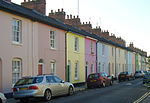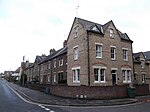Wyndham House, Oxford

Wyndham House is a retirement home in North Oxford, England.Wyndham House was officially opened in June 1973 by Queen Elizabeth The Queen Mother. Also in attendance were Fred Ingram, the Lord Mayor of Oxford, who was involved with the scheme to establish the project. Others present included Lady Jean Rankin, a lady-in-waiting, and the Duke and Duchess of Marlborough. The facility replaced a home for elderly people in Banbury Road in North Oxford. The site was provided by St John's College, Oxford, who historically owned much of the land in the area, locally called Walton Manor. Originally, Wyndham House was a project of the British Red Cross although the connection with the Red Cross ceased in 1976. The home was previously run by the Wyndham Housing Association. It is now run by the Anchor Hanover Group.Wyndham House is located on Plantation Road and also abuts Leckford Place off Leckford Road. Opposite on Leckford Place are part of d'Overbroeck's College (for Year 7 to Year 11) and a public house on the corner with Plantation Road, The Gardener's Arms.
Excerpt from the Wikipedia article Wyndham House, Oxford (License: CC BY-SA 3.0, Authors, Images).Wyndham House, Oxford
Plantation Road, Oxford North Oxford
Geographical coordinates (GPS) Address Website External links Nearby Places Show on map
Geographical coordinates (GPS)
| Latitude | Longitude |
|---|---|
| N 51.762658 ° | E -1.266966 ° |
Address
Wyndham House
Plantation Road
OX2 6JD Oxford, North Oxford
England, United Kingdom
Open on Google Maps










